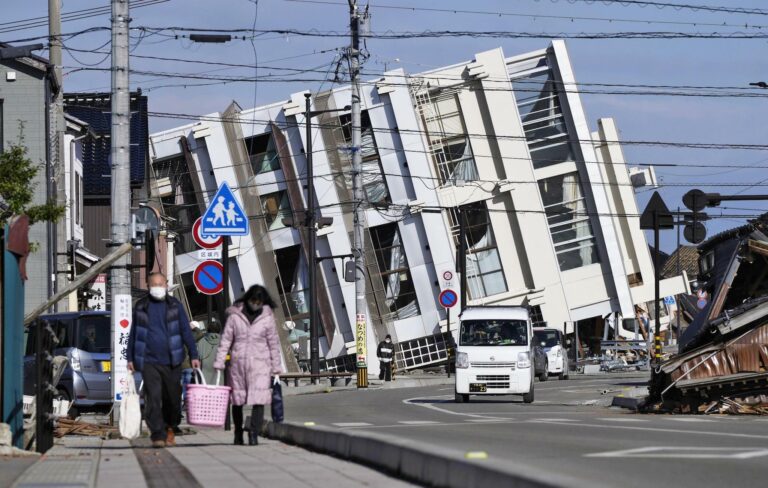Japan is a great travel destination, offering everything from 24-hour cities and hot springs to idyllic countryside and beaches. However, this country’s islands are located at the western end of the Pacific Ring of Fire, making it prone to natural disasters. In 2011, a magnitude 9 earthquake triggered an extremely devastating tsunami, killing approximately 18,000 people.
On Monday, January 1, a shallow magnitude 7.6 earthquake, just 10km deep, struck the west coast of Honshu. Hundreds of buildings were destroyed and there were numerous aftershocks. The current death toll stands at 64.
Here’s everything you need to know about traveling to Japan after the earthquake and tsunami warning.
Is it safe to travel to Japan?
It is not safe to travel to affected areas. West coast areas such as Niigata, Toyama, and Ishikawa. A series of major earthquakes began on Monday morning (January 1), one of which registered a magnitude of 7.6. The earthquake has killed at least 64 people so far. About 1,000 military personnel are trying to begin rescue operations on the hardest-hit Noto Peninsula, but damage and road closures are hampering efforts.
There’s plenty more advice on safety measures on the Japan National Tourism Agency’s website here.
Is it safe to travel to Tokyo after the earthquake?
Although Tokyo is 300 kilometers from the west coast where the quake occurred, buildings in the capital were reportedly still shaking. However, as Tokyo is located on the east coast, travel to the Japanese capital is not recommended.
At around 6:00 pm local time on Tuesday, January 2nd, a passenger plane collided with a Japan Coast Guard aircraft at Tokyo’s Haneda Airport, killing five of the six members of the Japan Coast Guard. The airport has since resumed operations.
How about Osaka?
There is little news about the earthquake’s impact on Osaka. The city is located at the eastern end of the Seto Inland Sea, about 350 kilometers from the Noto Peninsula on the opposite side of the epicenter of the earthquake on Honshu. There is no advice to recommend traveling to Osaka at this time.
Where in Japan was affected by the earthquake?
The area that suffered the most damage was the Noto Peninsula on the coast of Ishikawa Prefecture. The fire was still burning in the city of Wajima as of 7 a.m. local time on Tuesday, killing at least 15 people and destroying more than 100 buildings.
The Asachi-dori area, known for its wooden buildings, was the most severely damaged. Nanao City was also affected. According to the UK Foreign Office website, “Affected areas include Ishikawa, Yamagata, Niigata, Toyama, Fukui, Hyogo, Hokkaido, Aomori, Akita, Kyoto, Tottori and Shimane. In addition to the prefecture’s Sea of Japan coast, it also includes Iki and the Tsushima Islands. . ”
Is there still a tsunami warning?
Japan experienced a small tsunami after Monday’s earthquake, but the tsunami warning had been lifted as of Tuesday morning. The Met Office’s latest forecast shows slight sea level changes, the lowest level warning on the Met Office scale.
What are your rights if you book a trip to Japan?
Travel insurance often includes cancellation coverage if your trip is affected by a natural disaster, but we recommend checking directly with your insurance company.
What is the UK Foreign Office’s travel advice?
The UK Foreign Office website states: “On January 1, 2024, a series of earthquakes struck the Noto Peninsula in Ishikawa Prefecture, causing a small tsunami, multiple fires, and significant infrastructure damage across the prefecture. Aftershocks are possible and transportation may be disrupted.If you live in the affected area, please follow instructions from local authorities and check NHK World News for the latest information.
Was your flight canceled?
As of Monday night (January 1), All Nippon Airways had canceled 15 flights and Japan Airlines had canceled nine flights. According to Japan News, all flights at Noto Airport on the affected peninsula were canceled yesterday (January 2).
Why are there so many earthquakes in Japan?
According to the BBC, 20% of earthquakes of magnitude 6 or higher occur in Japan. Japan’s islands sit on the meeting of four plate boundaries (North American Sea, Eurasian Sea, Pacific Ocean, and Philippine Sea), meaning they are particularly prone to natural disasters such as earthquakes and tsunamis . The seismograph records some event every 5 minutes. average.
For all the latest travel news, sign up for our free Time Out Travel newsletter.

